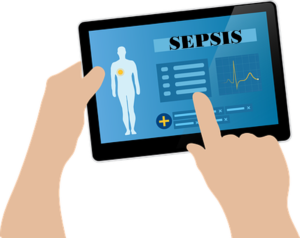The following was originally posted by PW blogger Jasmine Marcelin, MD, to the University of Nebraska Medical Center Division of Infectious Diseases blog.
The following is a summary of a recent ID Journal Club, presented and written by 2nd year ID Fellow Dr. Raj Karnatak:
Sepsis defined as “life-threatening organ dysfunction due to the dysregulated host response to an infection” [1]. Sepsis most commonly results from a bacterial infection, or less frequently from a fungal or viral infection. Sepsis is the most expensive condition treated in US hospitals with an aggregate cost of 23.7 billion US dollars annually [2]. The global burden of sepsis is estimated to be up to 30 million people every year, causing up to 6 million deaths [3]. The Surviving Sepsis campaignrecommend administration of effective antimicrobial therapy within one hour of identification of sepsis. Unfortunately, signs and symptoms of sepsis are non-specific, and early identification of sepsis remains to be a challenge.

A recent study published in the American Journal of Respiratory and Critical Care “Validation of a Host Response Assay, SeptiCyte LAB, for Discriminating Sepsis from Systemic Inflammatory Response Syndrome in the ICU” used a novel method for the early identification of sepsis [5]. The SeptiCyte lab is a host response assay that quantifies expression of 4 major genes (CEACAM4, LAMP1, PLAC8, PLA2G7) for the early identification of sepsis. This article combined findings obtained from 3 prospective observational studies and included a total of 447 patients from 7 sites in the United States and one site in the Netherlands. The primary objective of this study was to establish performances of the SeptiCyte test for the correct identification of sepsis from a non-infectious SIRS either as a stand-alone test or in combination with other clinical variables. The investigators used real-time, reverse-transcription, quantitative polymerase chain reaction (RT-qPCR) to measure sepsis gene expression after the extraction of mRNA from blood samples obtained from patients with suspected sepsis. After extraction of m-RNA, RT-qPCR provided a quantitative score (SeptiCyte score). In this study, the binary cutoff value for SeptiCyte score was 3.1: a value 3.1 or above was consistent with sepsis and a score of less than 3.1 was designated as non-infectious SIRS (systemic inflammatory syndrome).
The SeptiCyte test was evaluated in three different sepsis physician diagnosis groups (unanimous, consensus and forced). The ability of the Septicyte test to differentiate between sepsis and non-infectious SIRS was compared with other clinical variables such as procalcitonin, WBC count, mean arterial pressure, core temperature, and number of other SIRS criteria. Interestingly, SeptiCyte was found to be most accurate in differentiating between sepsis and non-infectious SIRS. SeptiCyte showed highest area under the receiver-operator curve (AUC), between 0.82 to 0.89. The procalcitonin AUC was 0.80 and AUC for other individual variables fell below 0.67. Notably, SeptiCyte correctly identified 100% of blood culture positive sepsis cases. The diagnostic performance of SeptiCyte only slightly increased in combination with procalcitonin. Combination of other clinical variables did not add up to further increase in AUC.

The SeptiCyte assay was approved by FDA in Feb 2017 as an indication for sepsis diagnosis in ICU patients, and efforts are being made to reduce test result time within 90 minutes. It will be interesting to see how SeptiCyte performance compares with other new and emerging rapid diagnostic tests to identify micro-organism directly from a blood samples.


 PWeekly
PWeekly
Create Post
Twitter/X Preview
Logout